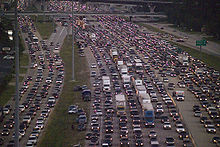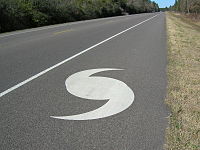- Contraflow lane reversal
-
Contraflow lane reversal refers to plans that alter the normal flow of traffic, typically on a controlled-access highway (such as a freeway or motorway), to either aid in an emergency evacuation (the most common usage of the term in the United States) or, as part of routine maintenance activities, to facilitate widening or reconstruction of one of the highway's carriageways (the most common usage in the United Kingdom).
Usually, the term is used to refer to reversal of lanes which are normally configured for travel in one direction; routinely changing the configuration of reversible lanes (such as during rush hour) is not normally considered contraflow lane reversal.
Contents
For use in emergency evacuation
In an emergency evacuation, contraflow lane reversal roughly doubles the number of lanes available for evacuation traffic. Crossover sections are used to move outgoing traffic to these lanes. All incoming traffic is blocked until the end of the evacuation.
Contraflow lane reversal is usually done on freeways and other controlled-access roadways; however, some examples listed below (particularly in South Carolina) are divided and undivided roadways. Use of contraflow lane reversal is generally considered to be an emergency measure, as the contraflow lanes (and any associated ramps at interchanges) lack proper signage, signals, and other traffic control devices needed to orderly conduct traffic in the opposite direction. Generally, a significant number of police officers or other officials are needed to manually direct traffic during a lane reversal (especially at interchanges, where ramp traffic in the wrong direction must intersect with other roadways operating normally).
Hurricane evacuation
Beginning in the 1990s, many states in the Southeastern United States adopted hurricane evacuation routes from coastal areas using contraflow lane reversals on Interstate Highways. State highway departments have coordinated on plans for traffic direction with state highway patrol agencies, constructed highway median crossovers, and installed signage for drivers and barriers and swing arms to inhibit wrong-way collisions.[1]
Most evacuation plans only involve a single state; however, the states of Louisiana and Mississippi have developed coordinated plans to evacuate the New Orleans metropolitan area using Interstate 55 and Interstate 59.
Current contraflow evacuation plans exist for:
- Alabama
- Florida[3]
- Jacksonville, via I-10
- Pensacola, via I-10 (eastbound)
- South Florida (Miami/Fort Lauderdale), via Florida's Turnpike and Alligator Alley
- Southwest Florida, via I-75
- The Space Coast, via SR 528
- Tampa Bay, via I-4
- Georgia
- Louisiana
- Lafayette, via I-49
- Lake Charles, via I-10 and I-210[5]
- New Orleans metropolitan area, via I-10, I-12, I-55, I-59, and the Lake Pontchartrain Causeway[6][7]
- Maryland
- Ocean City, via US 50 and Maryland Route 90[8][9]
- Mississippi
- New Jersey
- North Carolina
- Wilmington, via I-40[11]
- South Carolina[12]
- Beaufort, via U.S. 21
- Charleston, via I-26
- Georgetown County, via U.S. 17
- The Grand Strand, via U.S. 501
- Hilton Head Island, via U.S. 278
- Texas[13]
- Corpus Christi, via I-37
- Houston, via I-10, I-45, U.S. 290, and U.S. 59
- Freeport, Surfside Beach, and Lake Jackson via SH 288 and SH 36.
- Rio Grande Valley, via U.S. Highway 83 from Brownsville to McAllen, U.S. Highway 281 from Pharr to Falfurrias
- Virginia
- The Hampton Roads area, via I-64[14]
Highway reconstruction
When roads are undergoing construction amid heavy traffic, one lane of traffic may be blocked and another lane reversed.
Single track roads
Single track roads are often closed during reconstruction.
Two-lane arterials
A construction worker or police officer directs traffic with a sign displaying "STOP" on one side and "SLOW" on the other. The sign flips, and the other side proceeds. Traffic signals are also sometimes used, especially during bridge construction or any situation in which a lane must be closed during times when construction crews are not at work. Other cases include treating the street as a temporary one-way street in areas in which several nearby parallel streets are available as a detour for the opposing side.
Roads with four or more lanes
If road construction necessitates the complete closure of one half of a road with four or more lanes, two lanes of traffic may be shifted to the other roadway. If the road being constructed is a highway, the used half is called a semi-highway.
Freeways and motorways
When controlled-access highways undergo reconstruction, both sides are often reduced to one lane. In some cases, traffic may be shifted onto one half, making it a temporary two-lane freeway corridor. An example of this is Interstate 10 in Arizona, in which eastbound traffic is reduced to one lane and shifted onto the westbound half of the road.[15] Another technique is to treat the rightmost hard shoulder as a travel lane. On a six-lane freeway (i.e., one containing three lanes in each direction), a third lane may be kept open for the busier direction, or the shoulder may be opened to allow for four lanes of traffic but with little or no shoulder space; emergency breakdown areas may be added. In these situations, temporary "YIELD" or "STOP" signs are usually posted on merge ramps on freeways, expressways, and uncontrolled roads with interchanges.
Other situations
While these traffic plans may not necessarily be referred to as "contraflow", they share the essential feature of using lanes normally expected to carry one direction of traffic for vehicles traveling in the opposite direction.
Sporting events
At the beginning and end of major sporting events, the center turn lanes of roads around a stadium or arena may be used to accommodate event traffic. Because these lanes are typically not subject to lane control, this can be considered a limited form of contraflow reversal.
Mass transit
Contraflow bus lanes, areas in which a dedicated lane of an otherwise one way street is reversed for buses and other mass transit, exist in locations such as:
- Downtown Los Angeles, CA
- Pittsburgh, PA
- Belfast, Northern Ireland
- Through the Lincoln Tunnel between New Jersey and New York City
- Downtown Minneapolis, MN
- Leeds, England
- London, England
- Edmonton, AB
- Downtown Portland, OR[16]
- Boston, MA (for the Silver Line bus)
- Montreal, QC (Champlain Bridge)
- San Juan, PR
- Mexico City, Mexico
From June 1990 to June 2002, a similar line existed in Montreal, along Pie-IX Boulevard; this was indefinitely suspended after two fatalities. Government buses use a bus-only contraflow lane on Macquarie St in Hobart, Tasmania.
Tram lanes are an extension to this system found in cities with curbside streetcar networks. For example, tram lanes in Zagreb can be used only by trams, buses, and taxicabs.
Cycle lanes
In several cities, cycle lanes have been created to allow cycling in the direction opposite traffic on an otherwise one-way street. Sidewalks along one-way streets also allow for opposite direction cycling. Sidewalks along major thoroughfares in general allow 2-way bicycling regardless of motor vehicle travel side.
References
- ^ "Contraflow Evacuation". Floridaits.com. http://www.floridaits.com/Contraflow_Evac.htm. Retrieved 2008-09-01.
- ^ "MCEMA:: Mobile County Emergency Management Agency". Mcema.net. http://www.mcema.net/evac_routes.asp. Retrieved 2008-09-01.
- ^ "Microsoft Word - 050605 TWO45 FIHS Contraflow Rprt V1-5 _redl PLH_.doc" (PDF). http://www.floridaits.com/PDFs/TWO45_ContraFlow/050606-FIHS_Contraflow_Rprt-V1.pdf. Retrieved 2008-09-01.
- ^ "Savannah Georgia Westbound I-16 Hurricane Evacuation Map". Coastalstorms.com. http://coastalstorms.com/evac_west_map.html. Retrieved 2008-09-01.
- ^ http://www.ohsep.louisiana.gov/evacinfo/SWLAContraflowMap06.pdf
- ^ [1][dead link]
- ^ "Contraflow Evacuation Maps - New Orleans, Louisiana". Contraflowmaps.com. http://www.contraflowmaps.com/. Retrieved 2008-09-01.
- ^ a b http://books.google.com/books?id=6q2lOfLnwkAC&pg=PA169&lpg=PA169&dq=new+jersey+contraflow&source=bl&ots=-0W9n8n6-t&sig=r41hieZoaOxqgwHspkj6nDnyOVE&hl=en&ei=AHwoSva3IoyvtwfOuMzWBQ&sa=X&oi=book_result&ct=result&resnum=7
- ^ Wolshon, Brian (August 2001). "‘‘ONE-WAY-OUT’’: CONTRAFLOW FREEWAY OPERATION FOR HURRICANE EVACUATION" (PDF). Natural Hazards Review: 105–112. http://www.asce.org/uploadedFiles/Communications-NEW/Hurricane/One_Way_Out~Contraflow_Freeway_Operation_for_Hurricane_Evacuation.pdf. Retrieved 2010-09-13.
- ^ http://www.mdot.state.ms.us/Home/EmergencyPreparedness/pdf/ContraflowPlan.pdf
- ^ "NCDOT: Travel Information". Ncdot.org. http://www.ncdot.org/traffictravel/. Retrieved 2008-09-01.
- ^ "SCDOT - Getting Around in South Carolina - Coastal Evacuation Routes". Dot.state.sc.us. http://www.dot.state.sc.us/getting/evacuation.shtml. Retrieved 2008-09-01.
- ^ "Emergency Portal". Texas.gov. http://www.texas.gov/portal/tol/en/emergency/evacuating/#maps. Retrieved 2008-09-01.[dead link]
- ^ "Hurricane Evacuation Guide". Virginiadot.org. Archived from the original on June 8, 2008. http://web.archive.org/web/20080608010122/http://www.virginiadot.org/travel/reversal.asp. Retrieved 2008-09-01.
- ^ "Google Maps". Maps.google.com. http://maps.google.com/?ie=UTF8&z=17&ll=33.630566,-114.41146&spn=0.004315,0.008347&t=k&om=1. Retrieved 2008-09-01.
- ^ "TriMet: What's New on the Portland Mall?". TriMet. http://www.trimet.org/portlandmall/index.htm. Retrieved 2009-06-25.
Categories:- Emergency management
- Sports culture
- Road infrastructure
Wikimedia Foundation. 2010.


